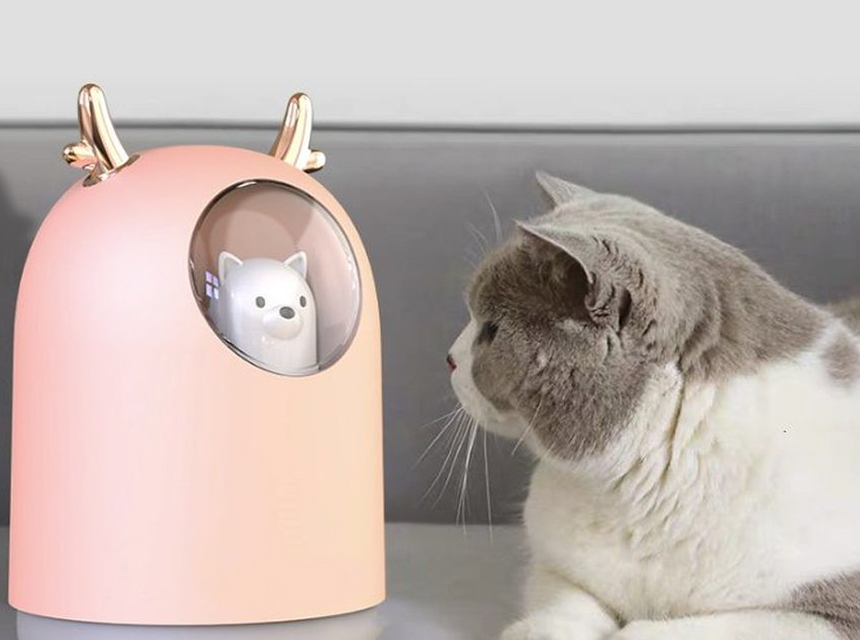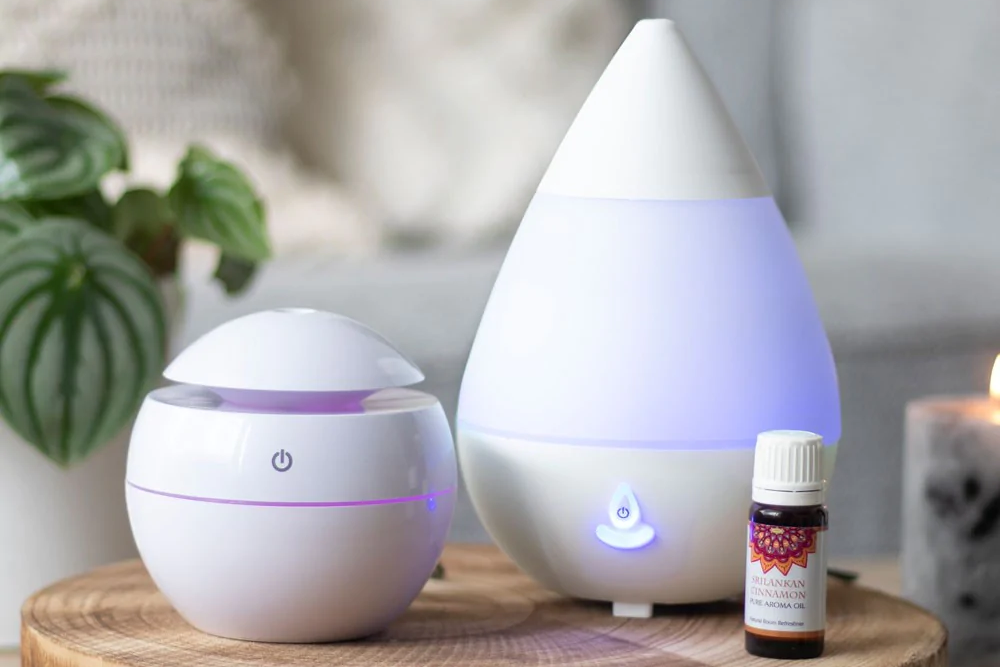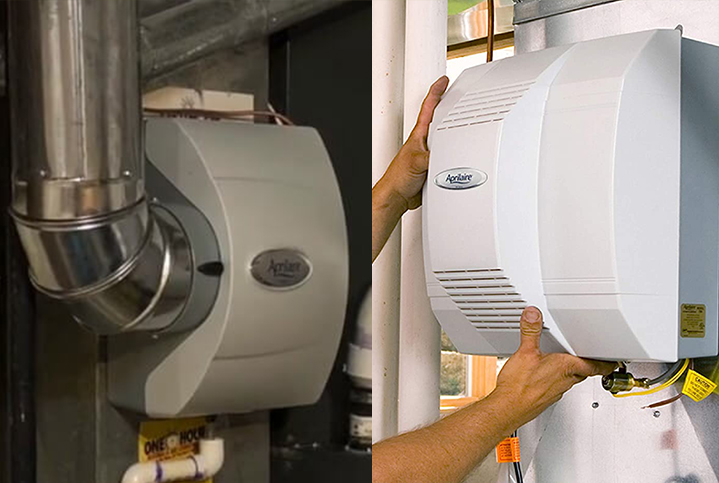

The dry air in your home can affect your baby as much as it can you. It can lead to dry noses, coughing, and sore throats. Babies also get colds, though they can’t use the medicines older children and adults have at their disposal to help relieve their symptoms. To help babies breathe better and get a good night’s sleep, you may want to try out the best humidifier for a baby. These little devices add the right amount of moisture in the air to help ease any nasty symptoms, making your baby feel better.
If you’re looking into a new humidifier for your little one, there are a few features worth looking at. One is the coverage area, so you know it will work well in the baby’s room. The tank capacity shows how much water it holds, while the runtime displays how long it will take to get through a full tank. You should also look at the noise level, especially if your baby is a light sleeper. If you have limited space, you may even want to check the dimensions of each model.
To help you choose the best humidifier for a baby, we spent a great deal of time researching different manufacturers, checking out their product’s features, and reading customer reviews. Then we chose the top models with the FridaBaby 3-in-1 Humidifier as our Editor’s Choice, created a comparison table, and wrote up in-depth reviews for each one. We also added a buying guide at the bottom to help you make the most informed choice possible.
More features: doubles as a diffuser and nightlight
The FridaBaby 3-in-1 Humidifier has just about everything you need to keep your baby comfortable all night long, making it the best-rated humidifier for baby around. It also has a stylish design, so it looks great while performing its many tasks.
This device’s main function is a humidifier. It uses ultrasonic vibrations to turn the water in the tank into a cool, soothing mist that moisturizes the air and keeps your baby breathing easily and comfortably. There is a rotating nozzle on top that allows you to point the mist in any direction you like.
To control the mist output, there is a large dial on the front of the machine. This lets you adjust the mist level as you see fit, depending on how dry the air in the room already is. The 0.5-gallon tank that gives you up to 12 hours of runtime. When the tank is empty, or you remove it to refill it with water, the auto-shutoff kicks in and turns the unit off.
This model includes small depression in the cap for adding BreatheFrida Vapor Drops or any of your favorite aromatherapy-grade essential oils. This diffuser adds a lovely scent to the air, plus could have some other benefits, depending on the oils you’re using.
Lastly, this humidifier is also a nightlight. It has three optional nightlight colors to choose from. The nightlight button is flush with the surface of the base, though, so could be hard to find in the dark.
More features: 360-degree mist nozzle; comes with a cleaning brush
The best humidifier for a baby room should have the features a little one needs to increase moisture in the air without disturbing their rest. The Pure Enrichment MistAire Ultrasonic Cool Mist Humidifier uses ultrasonic technology to safely add the moisture needed throughout the day or night. It emits a cool mist as well, so you can place it near the baby without worrying about any injuries from heated water.
The tank on this unit holds up to 1.5 liters of water and has a maximum runtime of 16 hours, so you only need to fill it once or twice a day, depending on how long you run it at a time. It also has two speed settings, low and high, so you can add as much or as little moisture to the air as needed. The nozzle on top rotates a full 360-degrees, so you can point it wherever you need it.
There is an optional nightlight to softly illuminate your baby’s room. The power light is also quite bright, so if your baby is disturbed by the light, you may need to cover this or at least turn the unit around to face the wall.
This humidifier has an automatic shut-off, which turns the unit off if the water level runs low or if you lift the tank off of the base. A disk cleaning brush is also included to make cleaning this humidifier much easier.
More features: multiple design options available; whisper-quiet
The Crane Filter-Free Cool Mist Humidifier for Kids comes in 16 different design options, including frog, cow, bumblebee, and penguin, just to name a few. Every design is adorable making them the perfect addition to any nursery or bedroom.
This humidifier has a large one-gallon tank, which has a maximum runtime of 24-hours, so you would only need to fill it once each day, and that’s only if you’re running it constantly. It does work best with distilled water, though, as other types may have some minerals that could leave white powder deposits on your furniture, due to the lack of a filter in the humidifier.
This model has a few safety features as well. It is made of anti-microbial material, which helps reduce mold and bacteria growth inside the machine by up to 99.96%. This makes it safer for your little ones to be around. It also has an auto-shutoff which turns off the humidifier if the water level runs low.
The ultrasonic technology sends a cool mist out into the room using a rotating nozzle. It is great for rooms up to 500 square feet. Instead of specific speed settings, this model has a dial that allows you to choose the amount of mist you want emitting into the room at any given time. It is also whisper-quiet to help little ones sleep.
More features: filter-free; tank handle
Cool mist humidifiers can also cool down the room it is working in. That’s why many people choose the best warm mist humidifier for a baby room during those cold winter months. The Vicks Warm Mist Humidifier is a great choice, releasing a warm mist that is 95% free of bacteria, so it is safe to breathe and clears up coughs and congestion.
The large tank holds up to a gallon of water, plus has a handle to make it easy to carry and fill it. It is also translucent, so you can keep an eye on the water level at all times. There are two mist levels, with a maximum runtime of 12 hours. The higher setting is a bit loud, though some compare it to a white noise machine, so it may not disturb your little one when they are sleeping. When the tank runs dry, the auto shut-off powers the humidifier down until it is refilled.
For some extra relief from your cold symptoms, there is a medicine cup that you can use with Vicks VapoSteam or any other liquid inhalants that you prefer. This helps keep your little one breathing easily all night long, so they wake up rested and happy.
Another handy feature that makes this a great model for a baby’s room is the nightlight. It comes on automatically when you turn on the humidifier, so can’t be turned off.
More features: starry night projection; Vicks VapoPads compatible
The best humidifier for baby cough and cold symptoms needs to do a bit more than just add some moisture to the air. Vicks humidifiers are known for their medicated uses, and the Vicks Starry Night Cool Moisture Humidifier is no exception.
The evaporative technology uses a wicking filter, which draws the water from the base of the unit. Then a fan blows the moisture out into the air in your child’s bedroom, adding the perfect amount of moisture.
If your child needs a bit more than simple hydration, there is also a slot on this model that allows you to add Vicks VapoPads, which use soothing vapors to help reduce congestion for a better night’s sleep.
This model for medium-sized rooms has a one-gallon tank that’s easy to fill. There are two fan speeds, high and sleep mode, so you can add the right amount of moisture no matter the time of day. The high mode is a bit loud, though, so is best used when the baby isn’t sleeping. You can also choose a soothing sleep-time scent for a better night’s rest.
Another great feature of this unit is the Starry Night projection. This sends a color-changing pattern of stars and the moon onto the ceiling. As well as giving your baby a comforting nightlight, this moving pattern can entertain them until they are ready to sleep.
More features: doubles as an oil diffuser; 15 lighting modes; timer
You don’t have to spend a fortune to get a decent humidifier for your baby’s room. The Cadrim Cool Mist Humidifier has a nice low price that can fit in any budget, plus has a few extra features that make it a great choice for your little one.
This whale-shaped humidifier can hold up to 200 ml of water, though this only gives you up to eight hours of mist, so you may need to fill it up more than once a day during the extra-dry seasons. It runs quietly, with an auto shut-off that kicks in after five seconds of the water running out.
This model is also a diffuser, allowing you to add your favorite essential oils directly to the water for some scent, as well as some extra health benefits for congestion relief.
Another great feature of this humidifier is the nightlight. It has seven colors to choose from, each of which can be set to dim or bright. You can also choose to cycle through the colors, giving you a total of 15 lighting options.
The nightlight and the humidifier have different power buttons, so you can use them independently or together as needed for your little one. You can also turn the LED light on or off by tapping twice on the top of the diffuser or the surface the humidifier is resting on, so you don’t need to try to find the button in the dark.
More features: dial knob mist control; 28 dB noise level
If you’re going to put a humidifier in your baby’s room, you want to make sure it won’t disturb them while they nap or during the night. It should only help them breathe better, relieving congestion for a more restful sleep. The VicTsing Cool Mist Humidifier covers you in both these areas.
This model is very quiet, with a motor that runs at only 28 decibels, which is quieter than whispering or rustling leaves. This keeps it from disturbing even the lightest sleepers, so your baby can get the rest they need for their healthy growth.
This ultrasonic humidifier has a 0.53-gallon tank which gives you up to 24 hours of cool mist to ease breathing issues and dry skin. The tank is translucent so that you can monitor the water levels at all times. It has a carry handle on top and a large opening for easily filling up and cleaning the tank. The base is a bit tricky to clean, though, due to some hard-to-reach nooks and crannies.
The mist output is adjustable using a classic dial, so you can add as much or as little moisture to your baby’s room as needed. The output nozzle rotates a full 360 degrees to send the mist out in any direction you like. When the water tank runs low, it automatically shuts off, and a red LED light comes on. This prevents damage while alerting you to the issue.
More features: built-in humidity sensor; whisper-quiet; 4 mist levels; essential oils compatible
The best humidifier for a baby nursery gives you complete control over the humidity level, plus has a few extras to make it a bit more worthwhile. The LEVOIT LV455CH works well in medium-sized rooms, due to its 1.1-gallon tank and it runtime of up to 36 hours.
This model has a built-in humidistat, which allows you to set a humidity level. It will then pump out the moisture until this level is reached. You can also choose one of four mist levels, set a timer for it to run, or choose Auto Mode and it will come on and off as needed to keep the moisture level how you like it. The machine runs quietly on all settings as well, so it won’t disturb your little one’s rest.
There is an LED screen on the front of the machine that tells you the humidity level in the room and displays all the settings you’ve chosen. Above this screen is a blue strip that you can use as a nightlight if needed in your baby’s room. An aroma box on the side lets you add some essential oils as well.
The tank has a large opening for easy filling and cleaning. You do need to make sure the cap is on tightly, though, or you’ll be dealing with some leaks. There is a water level indicator on the side, plus an auto shut-off when the water runs low.
Humidifiers are necessary for dry areas to keep much-needed moisture in the air and your baby’s room is no exception. When the smallest members of your family can’t breathe due to stuffy noses and congestion caused by dry air or cold symptoms, they can make life unbearable for the rest of your household. To help you find out exactly what to look for in the best humidifier for your baby’s room, check out the sections below.
When you’re setting up a room for a new baby, you may put a lot of attention into a bassinet or crib, changing table, lighting, toys, blankets, and so many other details. What a lot of parents don’t think of is adding a humidifier to their baby’s room. So, why does a baby need one of these units?
The main reason is that for the first four months, a baby doesn’t breathe through their mouth unless they are crying. These young ones need their nasal passages to stay clear and free of congestion. If the air in their room is dry, it can lead to stuffy noses and dry sinuses. This will affect their breathing, waking them up, and when you’re baby wakes up, so do you.
Even as they get older, this type of nasal congestion is common in dry areas or during the winter months. Sore throats are also added in since they start to breathe through their mouths when they sleep, so this makes babies even more uncomfortable.
If you add a humidifier to your baby’s room, the moisture in the air will prevent these issues, plus add some benefits, like loosening any mucus buildup. It also keeps their lips and skin from drying out, so they feel itchy and uncomfortable. This not only keeps them breathing well, but it also helps to improve your baby’s mood, so they will be more enjoyable to be around.
As well as the physical symptoms it gets rid of, some humidifiers offer some white noise, which many babies find comforting. It reminds them of the constant whooshing noises they heard while still in the womb, plus it covers the other household noises the baby may not be used to yet.
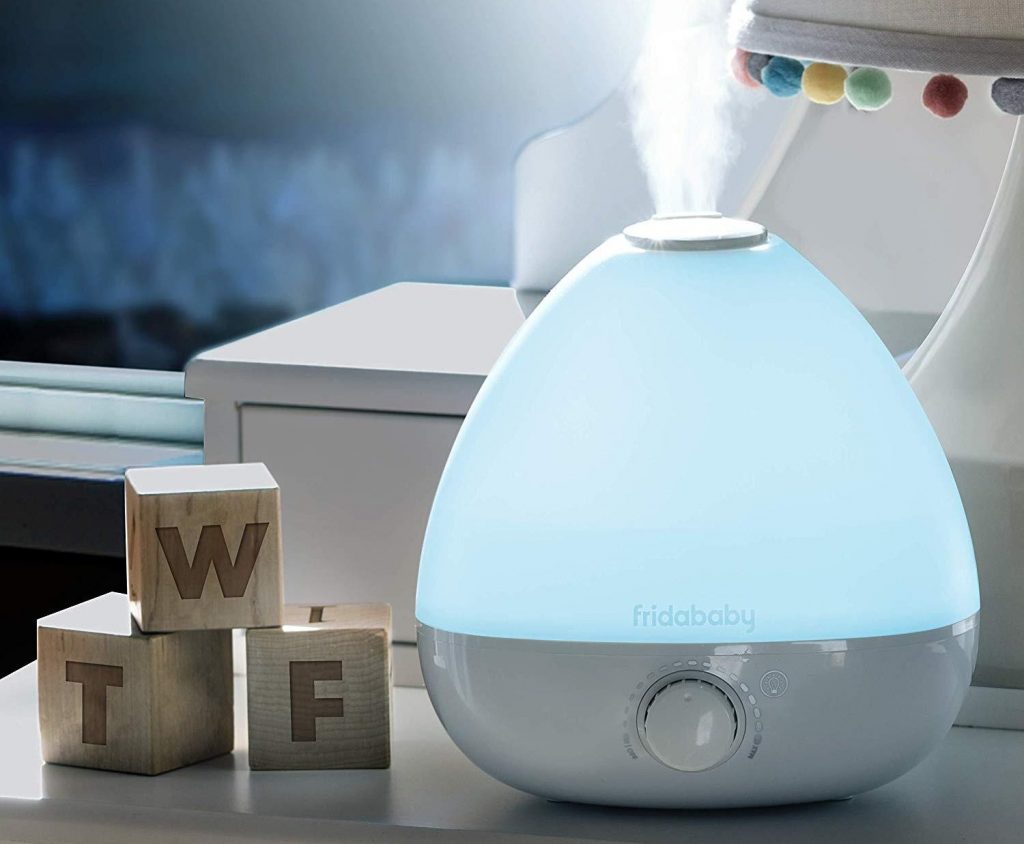
There are two types of humidifiers to choose from for your baby’s room. These are the cool mist or the warm mist models. Both types of humidifiers add moisture to the air, but they do so in different ways. Cool mist humidifiers, like the FridaBaby 3-in-1 Humidifier, use special technology to emit the moisture into the air without heating it. Warm mist humidifiers heat the water first, turning it into steam, which is then sent into the room.
Both models are quite effective when it comes to adding moisture to the air in your baby’s room, but some parents have their preferences. Cool mist humidifiers tend to lower the temperature in the room a bit as they’re running, so some parents think their baby will be cold. Warm mist humidifiers have the opposite effect, warming up the room as they do their work. They are also considered to emit healthier, bacteria-free mist as the water is boiled inside before being vaporized.
The downside to warm mist models is that it could be a bit dangerous to have around small children. This is due to the heated steam being emitted as well as the possibility of hot water being spilled and burning your little one. The warm mist models also tend to be a bit more expensive since they require a heating element, plus they bubble and hiss, which can add to their noise level.
The coverage area tells you the largest size the room can be for the humidifier to work at its optimal level. This is usually displayed in square footage, though some models just give a more general room size, like the Vicks Starry Night Cool Moisture Humidifier that states it works in medium-sized rooms. You should make sure that the size of the room is equal to or smaller than the room size recommended by the brand you’re buying. This will ensure that the humidifier can keep up with its task. If the room is too big, the humidifier may not be able to add the proper amount of moisture to the air, which defeats the purpose of running it in the first place. If you want to see some other options for your baby’s room, we recommend PureGuardian humidifiers, which also show excellent performance.
The size of the water tank is pretty important. The bigger the tank is, the more water it can hold, and the less often you have to fill it. When using it only once in a while, this may not seem like a huge issue. If your home is particularly dry or if your little one is sick and congested, you’ll likely be running your humidifier all day and night to help them breathe and sleep better, so a larger tank may be best. Models like the LEVOIT LV455CH have large tanks, which means less filling. This also increases their runtime, which we’ll discuss below.
The larger the tank is on your baby’s humidifier, the more water there is to disperse into the air. This also increases the runtime since there is more water for the humidifier to get through before it drains the tank. Though the Cadrim Cool Mist Humidifier is adorable, its tank is only 0.06 gallons, giving it a maximum runtime of eight hours on the lowest setting. The LEVOIT LV455CH has a 1.1-gallon tank, so it can run for up to 36 hours on the low setting. This means it can run for much longer than the smaller model will before you need to refill it. During those cold and flu seasons, this may be much more convenient.
When your baby is trying to sleep, you don`t want some noisy machine disturbing them. Since people of all ages use these units day and night, the humidifier manufacturers have incorporated technology that runs quietly, so their models don`t keep people awake all night. This is essential for new parents, who likely aren`t getting enough sleep as it is.
Most of the humidifiers that we`ve reviewed here run almost silently, even on the higher mist settings, so you won`t need to worry about them keeping your baby awake. The soft humming they do make may even be of some comfort to your baby, giving them white noise to remind them of their time in the womb while blocking out the other sounds of your house.
Your baby needs a lot more stuff when they are small, leaving limited space in their room. For this reason, you likely don`t want a bulky humidifier taking up that precious space. A smaller model is better to give your baby the moisturized air they need without sacrificing the space you have. Of course, if your baby`s room is quite large, this may not be as much of an issue, so a bigger model may not pose a problem.
You may also want to look at the weight, though you will likely only carry the entire unit once to unpack it and place it where you need it. If you are moving it in and out of their room to keep up with dry seasons or colds, though, a lighter model is better to keep your arms and back pain-free.
The warranty covers you in the case of manufacturing issues or defects with the humidifier you`ve bought, so you don`t have to spend extra money to repair a faulty machine. Most models come with at least a one-year warranty, which gives you plenty of time to check out the machine and make sure it`s working properly. Some also offer two- or three-year warranties, while brands like Fridababy offer lifetime warranties for their products.
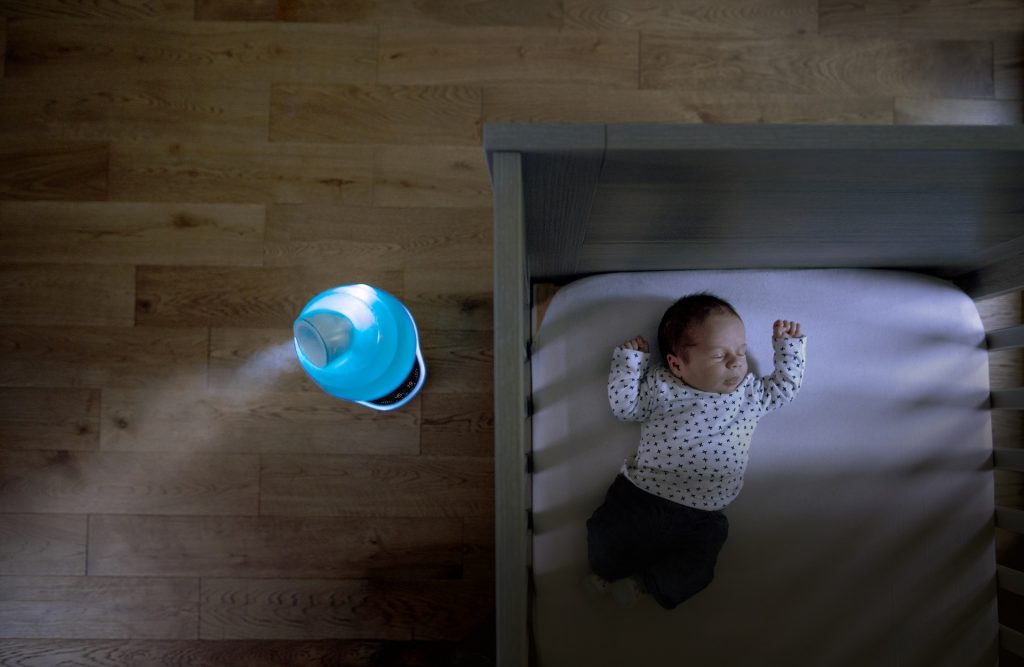
Simple controls are also a must, so you don`t have to spend too much time fussing with them to get the settings you want. A timer is handy if you only want the humidifier to run for a specific amount of time.
Since we`re talking about humidifiers for a baby`s room, a nightlight is also handy. Not only do these keep your baby happy, they also make it easier for you to move about their room if needed without turning on a light or bumping into stuff in the dark.
Oil diffusers can add some beneficial scents to your little one`s room. Some models, like the Vicks Starry Night Cool Moisture Humidifier, also let you add some sort of medicated pads or liquid to help ease congestion when you`re baby is sick.
Cleaning your humidifier is a necessary task. To do so properly, follow these suggestions:
The best humidifier for a baby deals with the dry air in your baby’s room, keeping their airways free of congestion, relieving any sinus issues, and helping them sleep, even if they’re sick. If you’re trying to decide which one is right for you, here are our top three choices.
Our favorite model is the FridaBaby 3-in-1 Humidifier. It is stylish and compact, with a rotating nozzle, a simple control dial, and an auto shut-off when the tank is lifted or empty. It also includes a diffuser and a nightlight with three color options.
Our second pick is Pure Enrichment MistAire Ultrasonic Cool Mist Humidifier. It uses ultrasonic technology to safely add the moisture needed throughout the day or night. The tank on this unit holds up to 1.5 liters of water and has a maximum runtime of 16 hours
The Crane Filter-Free Cool Mist Humidifier for Kids has an adorable design and large one-gallon tank, which has a maximum runtime of 24 hours.
